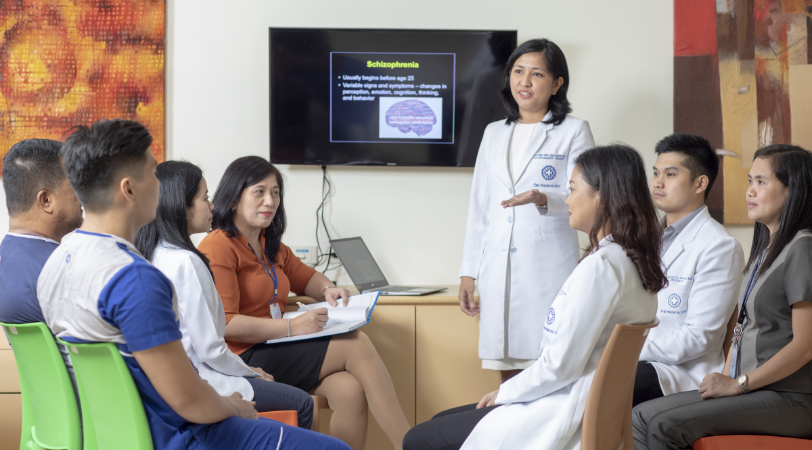The Medical City Institute of Neurological Sciences
4/F Podium Bldg., The Medical City, Ortigas Ave. Pasig City
Operating Hours: Open daily from 8:00AM to 5:00PM except Sundays and Holidays (All procedures are by
appointment only)
Contact Numbers
(632) 8-988-1000/(632) 8-988-7000 loc. 6270
PATIENT SERVICES
Parkinson’s Disease Treatment in the Philippines

What is Parkinson’s Disease?
Parkinson’s disease is a progressive neurological disorder that primarily affects movement. It occurs when nerve cells, or neurons, in the brain that produce dopamine, a chemical responsible for smooth, coordinated muscle movements, begin to break down or die.
This decrease in dopamine levels causes symptoms such as tremors, stiffness, slowness of movement, and balance problems. Parkinson’s is a chronic condition, meaning that it worsens over time, though the rate of progression can vary from person to person. Undergoing Parkinson’s disease treatment can also help manage the symptoms.
What Causes Parkinson’s Disease?
The exact cause of Parkinson’s disease remains unknown, but researchers believe it results from a combination of genetic and environmental factors. Here are some of the potential Parkinson’s disease causes and risk factors:
- Genetics: In about 10-15% of cases, Parkinson’s may be linked to inherited gene mutations. Several genes have been identified as being associated with Parkinson’s disease, and having a family history of Parkinson’s can increase the risk. However, in the majority of cases, Parkinson’s is not directly inherited.
- Environmental Factors: Exposure to certain toxins or environmental factors, such as pesticides, herbicides, and heavy metals, has been linked to an increased risk of developing Parkinson’s. Long-term exposure to these chemicals may damage the brain cells responsible for producing dopamine.
- Age: Parkinson’s disease most commonly affects older adults, with the majority of cases occurring in people over the age of 60. As we age, our brain cells become more susceptible to damage, making age the largest risk factor.
- Gender: Men are more likely than women to develop Parkinson’s disease, though the reasons for this difference are not entirely clear.
- Oxidative Stress: Some research suggests that oxidative stress, a process that damages cells due to the buildup of harmful molecules called free radicals, may contribute to the degeneration of neurons involved in Parkinson’s.
While these factors can increase the risk of developing Parkinson’s, having one or more risk factors does not mean you will necessarily get the disease. It is likely that a combination of several factors plays a role in the development of Parkinson’s.
How Do I Know If I Have Parkinson’s Disease?
The symptoms of Parkinson’s disease typically develop gradually and worsen over time. Early signs are often subtle and may go unnoticed, but as the disease progresses, the following Parkinson’s disease symptoms may become more apparent:
- Tremors: Shaking or tremors, particularly in the hands, fingers, or limbs, are one of the hallmark signs of Parkinson’s. Tremors often occur when the affected body part is at rest.
- Bradykinesia (Slowness of Movement): As the disease progresses, you may notice that your movements become slower. This can make everyday tasks such as buttoning a shirt, walking, or getting up from a chair more difficult.
- Muscle Rigidity: Stiffness or inflexibility in the muscles can occur in any part of the body, making movement difficult and sometimes painful.
- Postural Instability and Balance Problems: As Parkinson’s disease affects balance, it can lead to difficulties in standing upright or walking without stumbling.
- Changes in Speech: People with Parkinson’s often develop a softer, slurred, or monotone voice. They may also have difficulty enunciating words clearly.
- Changes in Writing: Handwriting often becomes smaller and more cramped, a condition known as micrographia, which is commonly associated with Parkinson’s disease.
- Non-Motor Symptoms: In addition to physical symptoms, Parkinson’s can also cause depression, anxiety, sleep disturbances, cognitive decline, and a reduced sense of smell (anosmia).
What are the Treatment Options for Parkinson’s Disease?
There is no cure for Parkinson’s disease. However, there are many treatment choices that can help manage the symptoms and improve quality of life. Treatment plans are tailored to each individual, depending on the severity of the symptoms and how the disease affects their daily life.
- Levodopa: The most commonly prescribed medication for Parkinson’s, levodopa is converted into dopamine in the brain, helping to replenish low dopamine levels and improve motor symptoms.
- Dopamine Agonists: These medications mimic the effects of dopamine in the brain and are often used in the early stages of the disease or in combination with levodopa.
- MAO-B Inhibitors: These drugs help prevent the breakdown of dopamine, allowing it to remain in the brain longer and improve symptoms.
- COMT Inhibitors: These are used to extend the effects of levodopa by blocking the enzyme that breaks down dopamine.
- Deep Brain Stimulation (DBS): In some cases, particularly in people who do not respond well to medication, DBS may be recommended. This surgical procedure involves implanting a small device in the brain that delivers electrical impulses to help control abnormal movements.
- Physical Therapy: Physical, occupational, and speech therapy can help improve motor skills, balance, and speech. Regular exercise is also important for maintaining mobility and reducing stiffness.
- Lifestyle Changes: Eating a healthy diet, staying physically active, and getting enough rest can help manage symptoms. Activities like yoga, tai chi, and swimming can improve balance and flexibility.
- Support Groups and Counseling: Parkinson’s disease can take an emotional toll, and joining support groups or seeking counseling can provide valuable emotional support for both patients and caregivers.